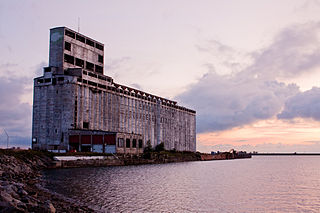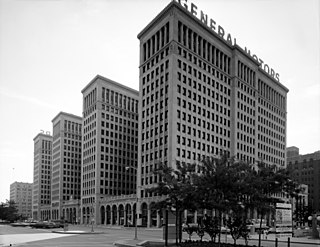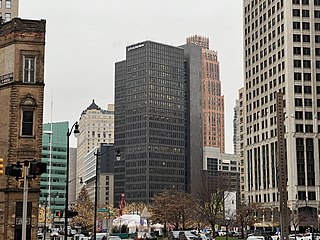
Fort McHenry is a historical American coastal pentagonal bastion fort on Locust Point, now a neighborhood of Baltimore, Maryland. It is best known for its role in the War of 1812, when it successfully defended Baltimore Harbor from an attack by the British navy from the Chesapeake Bay on September 13–14, 1814. It was first built in 1798 and was used continuously by the U.S. armed forces through World War I and by the Coast Guard in World War II. It was designated a national park in 1925, and in 1939 was redesignated a "National Monument and Historic Shrine".

A grain elevator is a facility designed to stockpile or store grain. In the grain trade, the term "grain elevator" also describes a tower containing a bucket elevator or a pneumatic conveyor, which scoops up grain from a lower level and deposits it in a silo or other storage facility.

Locust Point is a peninsular neighborhood in Baltimore, Maryland. Located in South Baltimore, the neighborhood is entirely surrounded by the Locust Point Industrial Area; the traditional boundaries are Lawrence street to the west and the Patapsco River to the north, south, and east. It once served as a center of Baltimore's Polish-American, Irish-American and Italian-American communities; in more recent years Locust Point has seen gradual gentrification with the rehabilitation of Tide Point and Silo Point. The neighborhood is also noted as being the home of Fort McHenry and the western end of its namesake tunnel that carries eight lanes of Interstate 95 under the river.

Cadillac Place, formerly the General Motors Building, is a landmark high-rise office complex located at 3044 West Grand Boulevard in the New Center area of Detroit, Michigan. It was renamed for the French founder of Detroit, Antoine Laumet de La Mothe, sieur de Cadillac. It is a National Historic Landmark in Michigan, listed in 1985.

The Carrollton Viaduct, located over the Gwynns Falls stream near Carroll Park in southwest Baltimore, Maryland, is the first stone masonry bridge for railroad use in the United States, built for the Baltimore and Ohio Railroad, founded 1827, and one of the world's oldest railroad bridges still in use for rail traffic. Construction began in 1828 and was completed in 1829. The bridge is named in honor of Charles Carroll of Carrollton (1737–1832), of Maryland, known for being the last surviving signer of the Declaration of Independence, the only Roman Catholic in the Second Continental Congress (1775–1781), and wealthiest man in the Thirteen Colonies of the time of the American Revolutionary War (1775–1783).

1001 Woodward is a 25-floor office building in Downtown Detroit, Michigan. It replaced the Majestic Building, a 14-story high rise on the same site. The building is located just south of the neighboring David Stott Building, at the corner of Woodward Avenue and Michigan Avenue overlooking Campus Martius Park. Constructed from 1963 to 1965, the 25-story building is designed in the International Style. It was listed on the National Register of Historic Places in 2013.

The Emerson Tower is a 15-story, 88 m (289 ft) clock tower erected in 1907–1911 at 21 South Eutaw Street, at the northeast corner of Eutaw and West Lombard Streets in downtown Baltimore, Maryland. It was the tallest building in the city from 1911 to 1923, until supplanted by the Citizens National Bank building at the southeast corner of Light and Redwood (German) Streets. It was designed by local architect Joseph Evans Sperry (1854-1930) for Isaac Edward Emerson (1859-1931), who invented the Bromo-Seltzer headache remedy.

The Commodore Apartment Building, also called Commodore Apartments, is a luxury condominium complex located in Louisville, Kentucky's Bonnycastle neighborhood. The building is listed on the National Register of Historic Places.

Northwestern Consolidated Milling Company Elevator A also known as the Ceresota Elevator and "The Million Bushel Elevator" was a receiving and public grain elevator built by the Northwestern Consolidated Milling Company in 1908 in Minneapolis, Minnesota in the United States. The elevator may have been the largest brick elevator ever constructed and ran on electricity. The elevator was the source for the Crown Roller Mill and Standard Mill. Those mills closed in the 1950s but the elevator continued in use for grain storage until the mid 1980s. The building is a contributing property of the Saint Anthony Falls History District listed in the National Register of Historic Places in 1971.

Helen Delich Bentley Port of Baltimore is a shipping port along the tidal basins of the three branches of the Patapsco River in Baltimore, Maryland on the upper northwest shore of the Chesapeake Bay. It is the nation's largest port facilities for specialized cargo and passenger facilities. It is operated by the Maryland Port Administration (MPA), a unit of the Maryland Department of Transportation.

Quaker Square was a shopping and dining complex located in downtown Akron, Ohio which is now used by the University of Akron. Quaker Square was the original Quaker Oats factory; the complex consists of the former mill, factory, and silos. The buildings were bought in the early 1970s by developers who sought to create a unique, useful home for shops and restaurants. The buildings were bought by the University of Akron in 2007. The hotel has been converted to a residence hall. The retail space consisted of dozens of small shops and restaurants, and there were large areas of historic exhibits on such areas as the local Quaker industry and history of radio in Akron, while offices were on the floors above. Quaker Square was open to the general public until September 18, 2015. The hotel no longer accepts reservations as the former hotel rooms and the entire complex is operated exclusively for student and university use. However, ballrooms are still available for catered events and conferences.

The Baltimore Gas and Electric Company Building is a historic office building located at Baltimore, Maryland, United States. It is the former headquarters of the old Consolidated Gas, Light and Electric Power Company of Baltimore City, which was a merger at the turn of the 20th century of the former century old Gas Light Company of Baltimore with several other formerly competing gas and electric power companies which had risen in the late 19th century, to form a single metropolitan wide unified utility system. In 1955, the old cumbersome Consolidated title was jettisoned and the utility rebranded as the Baltimore Gas and Electric Company (BG&E).

Concrete-Central Elevator is a historic grain elevator located on the Buffalo River at 175 Buffalo River Buffalo in Erie County, New York.
Preston J. Bradshaw (1884–1952) was one of the most eminent architects of St. Louis, Missouri, during the 1920s. Among his numerous commissions as an architect, he is best known for designing hotels and automobile dealerships in the region. Like many hotel architects of his time, he eventually moved into the actual operation of hotels, becoming owner and operator of the Coronado Hotel in St. Louis.

The Baltimore Terminal Subdivision is a railroad line owned and operated by CSX Transportation in the U.S. state of Maryland. The line runs from Baltimore to Halethorpe along the original Baltimore and Ohio Railroad (B&O) line, one of the oldest rail lines in the United States and the first passenger railroad line. At its east (north) end, it connects with the Philadelphia Subdivision; its west (south) end has a junction with the Capital Subdivision and the Old Main Line Subdivision.

The 1900 Rittenhouse Square Apartments is a historic high-rise building on Rittenhouse Square in downtown Philadelphia, Pennsylvania. It was built 1923–1926.

The Albers Brothers Milling Company building is a historic mill and contemporary office building located on the banks of the Willamette River in Portland, Oregon, United States. In the early decades of the 20th century, the German-immigrant Albers brothers built the largest flour and feed milling enterprise on the West Coast, headquartered in Portland and comprising operations in four states. This combined milling, warehousing, shipping, and office facility, built in 1909–1911, is the oldest remaining flour or feed mill in the city. The silos built into the south elevation of the building are painted with representations some of the mill's products as advertisements.























